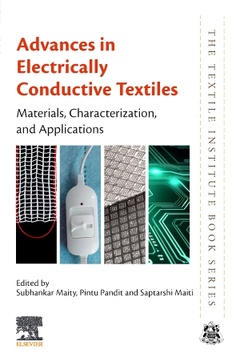Advances in Electrically Conductive Textiles Materials, Characterization, and Applications The Textile Institute Book Series
Coordonnateurs : Maity Subhankar, Pandit Pintu, Maiti Saptarshi

Advances in Electrically Conductive Textiles: Materials, Characterization, and Applications covers non-metallic electro-conductive textiles that are known for being polymeric, flexible, durable, moldable, and light weight. A brilliant quality of these textiles is the capability to alter conductivity through various external stimuli (e.g., strain, torsion, pH, humidity) to suit a specific application, such as sensors, heating garments, EMI shielding, and more. Based on these concepts, this book has been structured into three main sections that discuss the various preparation methods of electro-conductive textiles, their characteristics and features, and end-use applications and sustainability.
Section I: Introduction & Processing 1. Introduction to metallic and non-metallic conductive textiles 2. Preparation of conductive textile fibres and yarns 3. Preparation of conductive polymer coated textiles 4. Electrochemical deposition of conductive polymers onto textiles 5. Processing and preparation of graphene based electro-conductive materials 6. Preparation of Mxene based Electro-conductive textiles Section II: Characterization 7. Development of conductive polymer coated textiles for heat generation 8. Development of conductive polymer coated textiles for pH and humidity sensors 9. Development of conductive polymer coated textiles for gas sensors 10. Development of conductive polymer coated textiles for stress and strain sensors 11. Development of conductive polymer coated textiles for electro-magnetic shielding 12. Surface characterization and durability properties of electro-conductive composite textiles 14. Conductive polymer coated textiles for thermoelectric generators 15. Antimicrobial conductive textiles 16. Conductive polymer coated textiles for wastewater treatment 17. Interactive smart textile fabrics 18. Wearable flexible energy storage devices 19. Textile Electret Filter Media 20. Textile wearable antenna 21. Graphene based textiles for EMI shielding 22. Sustainability in production and opportunities of electro-conductive textiles
Dr. Pintu Pandit is an Assistant Professor at the Textile Design Department of the National Institute of Fashion Technology, India. He received his Ph. D (Tech.) degree in Fibres and Textile Processing Technology from the Institute of Chemical Technology, India. He obtained the IEI Young Engineers Award in 2020 from the Institute of Engineers (India) and Young Educator & Scholars Award in 2021 from the NFED (India). He has several research, review, and book chapter publications for national and international Scopus indexed journals in the areas of: Best out of waste; sustainability in textile and fashion; low-cost sustainable markets; natural dyeing; multifunctional finishing; graphene; atmospheric plasma technology, and nanotechnology. He has edited books for numerous prestigious publishers, including Woodhead publications (Elsevier). He has also published a series of chapters on “Graphene as a Wonder Material in the Journal of Textile Association (TAI).
Dr. Saptarshi Maiti is an Assistant Professor at the Institute of Chemical Technology (ICT), India, after completing his post-doctoral research from ICT-Mumbai in 2022. He holds a PhD (Tech.) and M. Tech in Fibres and Textile Processing Technology from the Department of Fibres and Textile Processing Technology, ICT-
- Includes new approaches and methodologies for electro-conductive textile composites
- Features non-metallic conductive textiles prepared from graphene, conductive polymers, MXene, and carbon nanotubes
- Contains applications of electro-conductive textile for heat generation, EMI shielding, sensors, anti-microbial, water purification, filtration, energy storage, and smart textiles
Date de parution : 09-2024
Ouvrage de 560 p.
15x22.8 cm



